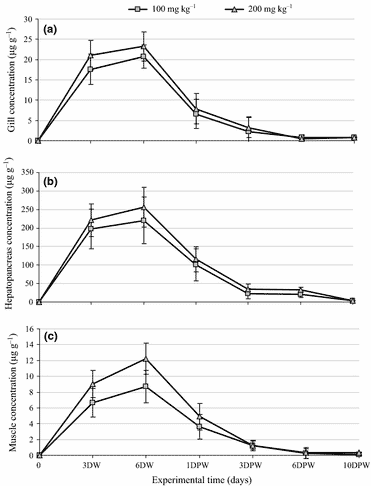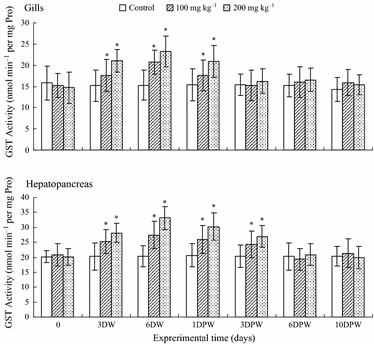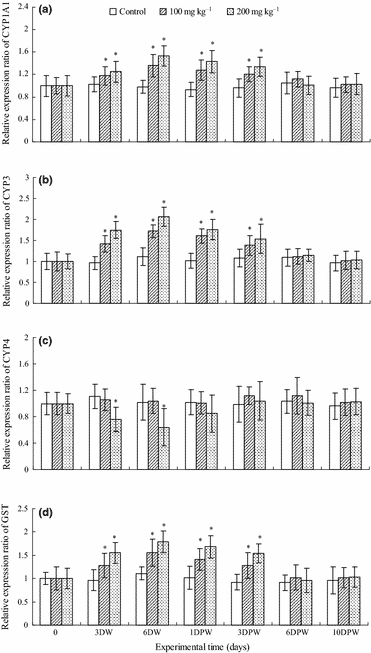The white shrimp Litopenaeus vannamei has become the most important cultivated shrimp in China owing to its fast growth rate and strong adaptability. Recently, diseases have become a serious problem causing huge economic losses in shrimp farming (Jayasree, Janakiram & Madhavi 2006; Chiu, Guu, Liu, Pan & Cheng 2007). Therefore, the development of solutions for improved resistance and survival of shrimp with pathogen infection is crucial to sustain the shrimp culture industry.
Chemicals and antibiotics are widely used to prevent or treat such infections (Helena Rebouças, Viana de Sousa, Sousa Lima, Roger Vasconcelos, de Carvalho & dos Fernandes Vieira 2011). The use of these antimicrobial drugs in aquaculture has their positive effects; however, several hazards and side-effects on both the shrimp and the environment are associated with their excessive use (Yonar 2012). These include immunosuppression, decreased growth and increased incidence of resistant bacterial strains (Zaki, Eissa & Saeid 2011), environmental problems such as drug residues in farm sediments as well as drug residues in shrimp products (Saglam & Yonar 2009).
Florfenicol (FLR) is the most commonly used antibacterial drug in world aquaculture, which is a synthetic drug with chemical structure and spectrum of bactericidal activity similar to chloramphenicol, and has been shown to have potent activity against several pathogenic bacteria (Caipang, Lazado, Brinchmann, Berg & Kiron 2009; Fodey, George, Traynor, Delahaut, Kennedy, Elliott & Crooks 2013). Previous FLR pharmacokinetic studies in aquaculture were performed mainly on finfishes (Malvisi, Della Rocca, Anfossi, Tomasi, Di Salvo, Zanchetta, Magni, Sello & Giorgetti 2002; Lewbart, Papich & Whitt-Smith 2005; Park, Lim, Kim & Yun 2006; Sun, Zhao, Shan, Zhu, Zeng & Liu 2010; Lim, Kim, Hwang, Song, Park & Yun 2011; Zaki et al. 2011; Zhao, Zhang, Bai, Zhu, Shan, Zeng & Sun 2011).
The results showed that the drug was absorbed rapidly, extensively distributed and the bioavailability of FLR ranging from 91% to 99% in seawater fish was excellent. Christensen, Ingerslev and Baun (2006) found FLR also had potential use in the treatment of vibriosis and necrotizing hepatopancreatitis infections in farm-raised shrimp. The pharmacokinetic data available for finfishes may not apply, because shrimp are species with very different anatomy and physiology. In fact, there is some evidence that shrimp may metabolize and excrete pharmaceuticals more slowly than vertebrates. Although FLR was approved by the FDA for use in shrimp aquaculture, little is known about the pharmacokinetic of FLR in shrimp.
The pharmacokinetic characteristics of FLR in shrimp need to be more thoroughly understood to determine the optimal dose regimens for achieving and maintaining therapeutic drug levels as well as predicting the residue withdrawal time in edible tissues of treated shrimp. Therefore, it is necessary to investigate the pharmacokinetics and corresponding mechanisms of FLR in L. vannamei.
Drugs are usually lipophilic, which allows them to enter their site of action of target organs or tissues via cell membranes and exert their effect. As lipid soluble compounds, it is difficult to eliminate from the body. Metabolism, or biotransformation of these compounds into more polar, inactive metabolites, is generally an enzymatic process (Topic Popovic, Klobucar, Strunjak-Perovic, Jadan, Barisic & Coz-Rakovac 2013). The major pathway for lipophilic xenobiotic elimination including cytochrome P450s (CYP450s) mediated metabolism in the vertebrate liver or analogous invertebrate tissues (Rewitz, Styrishave, Løbner-Olesen & Andersen 2006).
CYP450s comprising a multigene family of hemo-proteins are responsible for the metabolism of numerous xenobiotics, including therapeutic drugs, environmental chemicals and dietary constituents, as well as such endogenous compounds as steroids and bile acids (Rewitz et al. 2006). P450s gene mRNA expression, protein levels and P450 mediated metabolism of xenobiotics have been induced in some marine invertebrate species. Thus, regulation of P450 enzyme activity may play a central role in the adaptation of animals to environmental pollutants. Emphasis should be put on the elucidation of the function and regulation of the ever-increasing number of marine invertebrate P450s.
The CYP450 of CYP1, CYP2, CYP3 and CYP4 family are mainly involved in the detoxification of xenobiotics (James & Boyle 1998). CYP 1A1 isozyme being the predominant (Dam, Rewitz, Styrishave & Andersen 2008), and ethoxyresorufin-O-deethylase (EROD) activity can reflect its' activity (Rewitz et al. 2006). In phase II, the xenobiotics metabolites are conjugated with polar endogenous constituents such as glutathione-S-transferase (GST), to produce water-soluble conjugates that are easily excreted (Rey-Salgueiro, Costa, Ferreira & Reis-Henriques 2011). Our laboratory has mapped the transcriptome of the white shrimp L. vannamei (Accession: SRR346404, unpublished). It shows that L. vannamei appears to have orthologs of several key enzymes that are involved in the metabolic steps, including CYP1A1, CYP3 and CYP4, which provides powerful evidence for the existence of vertebrate-type enzymatic pathways in L. vannamei.
Administration of antibiotics incorporated in the food has been considered the most convenient way to medicate farmed animals (Fang, Li, Zhou, Li, Hu & Zhou 2013), in part because the amount of drug required for this type of treatment is considerably lower than that needed for administration through the water and, thus, the quantity of residuals entering into the surrounding environment is also lower. The aim of this study was (i) to evaluate the distribution and elimination of FLR, and (ii) to investigate the enzymes and mRNA levels of genes involved in metabolism in the healthy white shrimp following oral administration. Parameters presented here will be helpful for further studies of pharmacodynamics and metabolic progress of antibiotics.
Results
Tissue distribution and elimination
The tissue concentrations of FLR during or after oral administration at a dose of 100 and 200 mg kg−1 are shown in Fig. 1. During oral administration of FLR, the FLR concentration in the three tissues increased, and peaked at day 6. The distribution of FLR varied from tissue to tissue. The hepatopancreas had the highest FLR concentration, and the order was hepatopancreas> gill> muscles. After post-withdrawal of FLR, the FLR concentrations were followed by a rapid decrease until 3 days post withdrawal.

Enzyme parameters
EROD activity
The effects of oral administration of FLR on EROD response in gill and hepatopancreas are shown in Fig. 2. The results showed that the EROD activity in gill and hepatopancreas of 100 and 200 mg kg−1 treatment groups increased and became significantly different from control values at day 3 of FLR feeding. After post-withdrawal of FLR, the EROD activity in gill and hepatopancreas of the both treatment groups decreased, and at 6 day post withdrawal, the EROD activity returned to the initial level.
.png)
GST activity
Results of GST activity in gill and hepatopancreas are presented in Fig. 3. It showed that changes of GST activity in gill and hepatopancreas shared a similar pattern: in the FLR-fed stage, GST activity was elevated, and peaked at day 6 (P < 0.05). After post-withdrawal of FLR, the GST activity decreased, and had no difference compared with the control group from day 6 post withdrawal of FLR until the end of the experiment.

Expression of metabolism-related genes
The effects of oral administration of FLR on mRNA expression of genes responsible for hepatopancreas metabolism in the white shrimp were determined (Fig. 4). In the FLR-fed stage, both the FLR treatments caused mRNA expression of CYP1A1, CYP3 and GST to increase significantly in a dose-dependent manner. After stopping feeding with FLR, the mRNA expression of CYP1A1, CYP3 and GST decreased, and returned to the initial level at 6 day post withdrawal of FLR.

Discussion
Tissue distribution and elimination of FLR in L. vannamei
In crustaceans, there is substantial evidence that the hepatopancreas plays a role not only in metabolism and elimination but also in absorption (Verri, Mandal, Zilli, Bossa, Mandal, Ingrosso, Zonno, Vilella, Ahearn & Storelli 2001; Faroongsarng, Chandumpai, Chiayvareesajja & Theapparat 2007). After oral administration, the drug is delivered from the shrimp stomach to the hepatopancreas, where both the drug uptake into and elimination from the body take place competitively (Tu, Silvestre, Phuong & Kestemont 2010). In the present study, the peak concentrations of FLR in hepatopancreas were higher than those in gill and muscle, further illustrating that the drugs were absorbed from the stomach to hepatopancreas of the shrimp. After 6-day oral administration of FLR, the descending in the order of peak FLR concentration was hepatopancreas> gill> muscles.
The maximum concentration was found in the hepatopancreas, which is the main feature of oral administration. This phenomenon was also observed in other crustaceans, such as sulfadimethoxine in American lobster Homarus americanus (James & Barron 1987), ormetoprim in the shrimp, Penaeus vannamei (Park, Lightner, Milner, Mayersohn, Park, Gifford & Bell 1995), triclopyr in the crayfish, Orconectes propinquus (Barron, Hansen & Ball 1991), and oxytetracycline in Pacific white shrimp (Faroongsarng et al. 2007). As a respiratory organ, gill direct contact with water, the drug concentration in gill is higher than that in muscle. It demonstrated that like the finfish, gill also plays an important role in excreting drugs. This observation was not in agreement with findings in some finfishes.
The order of FLR concentration in freshwater tilapia following a single oral dose of 10 mg kg−1 body weight of FLR was kidney> gill> liver> muscle (Feng, Jia & Li 2008), and in the order of FLR concentration in carp after a single dose 80 mg kg−1 injection was kidney> muscle> liver> gill (Huang, Sun, Li & Huang 2006). These results indicate that pharmacokinetics of FLR is affected by parameters such as species, route of administration and experimental conditions (Intorre, Cecchini, Bertini, Cognetti Varriale, Soldani & Mengozzi 2000). For this reason, the extrapolation of pharmacokinetic data obtained in one species to another species, living under different conditions, should be performed with caution (Haug & Hals 2000; Pontes, Arruda, de Lara, Menezes & Pereira de Lima 2006).
The design of treatment regimes and the prediction of their possible clinical outcomes represent an important application of pharmacokinetic data. Frequently, the efficacy of an antimicrobial drug is related to its capacity to reach and maintain adequate concentrations at the site of infection. For a bacteriostatic drug like FLR, Shojaee AliAbadi and Lees (2000) suggested that an optimal regimen should maintain concentrations at the site of infection in excess of its minimal inhibitory concentrations (MICs) value for the relevant pathogen during the entire medication period. Feng and Jia (2009) reported that the MICs value of FLR against a number of gram-negative and gram-positive pathogens isolates were very low (≤1.6 μg mL−1).
Roque, Molina-Aja, Bolán-Mej?a and Gomez-Gil (2001) determined the in vitro susceptibility to FLR of 98 strains of Vibrio spp. (are the bacteria that can cause the disease. Vibriosis is the disease caused by Vibrio spp) isolated from shrimp in northwestern Mexico, and the mean MIC was 1.79 μg mL−1. Our results showed that the concentrations in all tissues were between 1.81 and 35.23 μg g−1 at 3 days after oral administration, exceeding the MIC values above with good margin, while at 6 days after oral administration, the concentrations in all tissues were lower than the MIC values. Therefore, following oral administration 6 days and with a 3 days withdrawal period at a dose of 100 mg kg−1 FLR with the antibiotic properly incorporated into feed, FLR should be suitable for treatment of these common bacterial infections in shrimp farming. In addition, it still requires performing such studies in natural farming conditions.
The metabolic progress of FLR in L. vannamei
There have been several studies on the metabolic progress of antibiotics in fish; however, their effects on the metabolism responses have not been well-studied in crustaceans. Biotransformation of xenobiotics in eukaryotic species is often initiated by a monooxygenase reaction (introduction of a functional oxygen group), which is catalysed by the cytochrome P450 enzymes (phase I). CYP1A1 in crustaceans has been widely studied as biomarkers in biomonitoring or toxicity evaluation, which can be assessed by measuring EROD (Rocha, Gomes, Passos, Hasue, Santos, Bicego, Taniguchi & Ngan 2012.).
In phase II, the metabolites are conjugated with polar endogenous constituents to produce water-soluble conjugates that are easily excreted. Glutathione-S-transferase (GST) is an enzyme in phase II metabolism, which has been established as a suitable biomarker for aquatic contamination. In our study, we have observed a significant increase in EROD and GST activities in both tissues of 100 and 200 mg kg−1 FLR dose in comparison with control. These results suggest that enzymes of EROD and GST play an important role in detoxification of FLR.
Studies to date of biotransformation in the hepatopancreas and other non-endocrine tissues in crustaceans have shown that substrates normally metabolized in mammals by CYP2 and CYP3s' families, such as benzphetamine, aminopyrine, erythromycin, imipramine and steroid hormones (degradation pathways) are better substrates for crustacean CYP 450s than substrates normally metabolized by CYP1's family, such as ethoxyresorufin (James & Boyle 1998). In humans, CYP3 is believed to play the central role in drug metabolism since it is responsible for the metabolism of the largest number of currently used drugs (Watkins 1994).
As in the mammalian system, CYP3A was found in fish, it reported that CYP3A is inducible by steroidal chemicals and by a variety of compounds, including naturally occurring and synthetic glucocorticoids and macrolide antibiotics (reviewed in Quattrochi & Guzelian 2001). GST is one of the most studied genes in crustaceans concerning the metabolism of contaminants. Gonçalves-Soares, Zanette, Yunes, Yepiz-Plascencia and Bainy (2012) reported that after injection with a sub-lethal dose of a toxic Microcystis aeruginosa extract in L.vannamei, MCs caused up-regulation for GST. To our knowledge, this study is the first to explore the effects of oral administration of antibiotics on the transcription of selected genes related to metabolism system in the white shrimp.
In our results, among the metabolism-related genes, the FLR resulted in the up-regulation of CYP1A1, CYP3 and GST during oral administration of the antibiotic and continued to exhibit such level of expression even until the 1st day post withdrawal. The mRNA expression of CYP1A1 and GST and related enzymes EROD and GST activities have the same trend. After 6 day oral administration of FLR, the mRNA expression of CYP1A1 and GST and related enzymes EROD and GST activities reached their highest level. After stopping feeding of FLR, the genes expression and enzymes activities returned to the initial level at 3 day post withdrawal of the FLR.
It has previously been suggested that CYP4 enzymes in insects involved in xenobiotic biotransformation (Danielson, Foster, McMahill, Smith & Fogleman 1998). The aforementioned results indicate that CYP4 enzymes belong to different subfamilies may have different responses to xenobiotic, which may relate to their functions. The opposite results about the effects of xenobiotic on the abundance of CYP4 isoforms were also seen in invertebrate species. Expression of a CYP4 isoform in the polychaete Nereis virens was found 2.6-fold when induced by exposed to benz (a) anthracene (0.015 mg g−1 sediment) (Rewitz, Kjellerup, Jørgensen, Petersen & Andersen 2004).
On the contrary, the CYP4Y1 mRNA in Mytilus galloprovincialis was seen to decrease in a dose–response manner after exposure to β-naphthoflavone (0.5 or 5.0 mg L−1) (Snyder 1998). Our results are consistent with the latter, the mRNA expression decreased during oral administration of 200 mg kg−1 FLR and returned to the initial level at 3 day post withdrawal of the antibiotic. Additional studies are needed to clearly establish the link between oral administration of the antimicrobial drugs and metabolic progress in L.vannamei.
In crustaceans, the hepatopancreas is the key metabolic centre for the detoxification of xenobiotics (Zhou, Wang, Wang, He, Zhou, Liu & Xu 2009; Gonçalves-Soares et al. 2012). In this study, EROD and GST activities were different between gill and hepatopancreas even under control conditions. These results suggest that tissue-specific functions and metabolic rate can influence antioxidant enzyme activities in the white shrimp. Hepatopancreas is considered to be more susceptible to xenobiotic during the transition due to its high metabolic rate and its role in digestion, storage of reserve material, metabolism of lipids and carbohydrates, absorption and detoxification processes (Fang et al. 2013).
Conclusion
In conclusion, the pharmacokinetic profiles of FLR were shown, and the rapid absorption, extensive distribution and quick elimination of this drug were also demonstrated. In the white shrimp, FLR was distributed more extensively and eliminated more quickly in hepatopancreas than that in the other tissues. This study has shown that oral administration of FLR in L. vannamei resulted in the differential regulation of the metabolism system. Furthermore, there was enhanced transcription of CYP1A1, CYP3 and GST genes in the hepatopancreas but differential effects on the expression level of CYP4.
The results obtained from this study provided valuable information on establishing a link between the metabolism system and antibiotics administration in the white shrimp. Therefore, these results will have an impact on the provision of efficient management strategies in maintaining shrimp welfare and proper husbandry procedures. The EROD and GST activities in gill and hepatopancreas, the mRNA expression of CYP1A1, CYP3 and GST in hepatopancreas were affected by both treatment and exposure time following oral administration. These parameters may be potential indicators for antibiotics evaluation.
Acknowledgments
This research was supported by the National Marine Public Industry Research Project ‘large-scale park aquaculture environment engineering ecological optimization technology integration and demonstration’ (201305005). We thank the staff at the Laboratory of Environmental Physiology of Aquatic Animal for help with sampling and taking care of the shrimp.
February 2015




